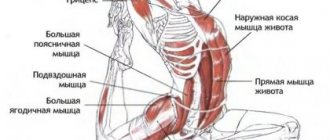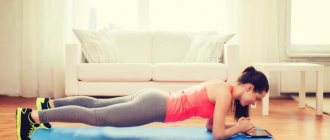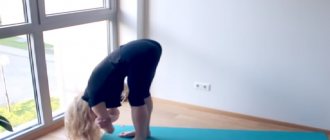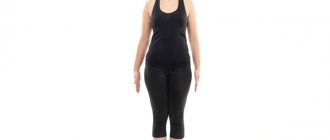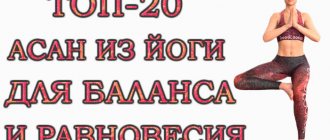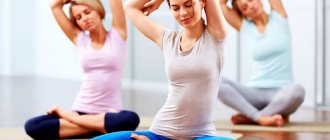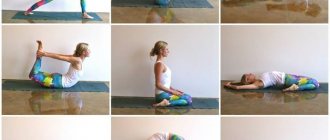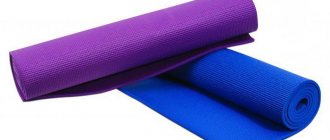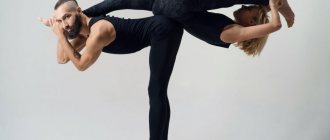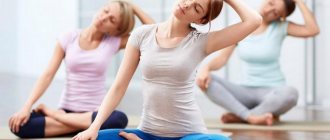Matsiasana technique for beginners
For beginners, fish pose is performed in an easy version:
- Starting position: lying on your back, legs extended and joined together. Hands are placed under the buttocks.
- As you inhale, raise your head, shoulders, and torso, focusing on the forearm and hands of the upper limbs. Straightening your chest, try to lift your body up, but press your legs and buttocks to the floor.
- As you exhale, focus on your elbows, arching your body, and lower your head. For more experienced people, you can complicate the exercise by taking your hands from under your body and folding them on your chest.
- Breathing is calm.
- Place your hands along your body. As you exhale, focus on your palms and slowly lower your back without straining. Relax with your hands palms up.
Fish pose can also be performed from other starting positions:
- bend your knees and grab your shin with your hands, make a deflection;
- sit on your heels, hands on your hips and bend over;
- sit on the floor between your heels, hands grab your shins.
The first time in the asana is recommended for only 10 seconds. Gradually increase the time spent in the pose to 60 seconds.
When the Matsiasana asana does not cause pain or discomfort, you can stay in it for about three minutes. For therapeutic purposes, two minutes is enough.
During execution, the following errors often occur:
- no emphasis is placed on the elbows;
- knees are not pressed to the floor.
Matsiasana. Options
There are various options for performing this pose, subject to the general rules of execution technique.
Option with straight legs
Starting position : Sit on the floor, legs straight and pressed together. Place your hands with your palms on the floor next to your pelvis with your fingers facing forward.
Perform matsiasana , following the general principles - throw back your head, bend your spine forward and, at the same time, tilt your torso back, leaning on your elbows, until the crown of your head drops to the floor. The movement is performed while inhaling.
We fix the pose while holding while inhaling . Then we return to the starting position. In this case, we perform the movement in the reverse order, leaning on the elbows.
Note : when holding a pose for a long time, breathing is free.
Full asana, execution sequence
This technique is for advanced people. In order for the Pisces pose to be methodically correct, you need to do the following:
- Take a lotus position or sit cross-legged.
- Do several breathing cycles.
- As you exhale, slowly lower yourself back, focusing on your elbows and arching your spine, your head tilts back. The legs remain in the same position.
- Straighten your chest (this will help relieve bronchospasms).
- Hands can rest on your hips or reach up.
Matsiasana - fish pose in yoga
Matsyasana or fish pose (matsya means fish in Sanskrit, asana means pose) is one of the classic yoga poses.
You can find the name of this asana in another transcription – matsyasana. Usually performed after inverted poses such as halasana, sarvangasana, shirshasana, as a counter pose. Or after poses with a strong stretch of the spine, such as padhastasana or paschimottanasana.
Effect of asana
Matsiasana is important in yoga. Be sure to include it in your complex , since the asana will bring great benefits to the body:
- expands the chest;
- will help with breathing problems;
- relieves tension in the cervical region;
- develops the heart muscle;
- the activity of the upper body is activated;
- ventilation of the lungs occurs, which increases their vital volume;
- improves the activity of the thyroid gland;
- heals the blood vessels of the brain;
- energy is distributed in the upper body;
- improves the functioning of the kidneys, spine, and abdominal organs;
- The muscles of the legs, back, neck, and abdominals are involved in the work.
In the therapeutic direction, Matsiasana will be beneficial for diseases such as:
- asthma;
- pneumonia;
- scoliosis;
- sore throat, cold.
It is recommended to use the described pose for curvatures of the spine - this will give a good effect.
Matsyasana should be performed with caution if you have problems with your neck, shoulders or back. In this case, there is no need to overdo it and overexert yourself so as not to cause harm to the body.
Why do a plank: the benefits of the exercise
This yoga asana strengthens the arms and wrists in preparation for other yoga poses such as crow pose (bakasana) and handstand (adho mukha vrksasana). Variations of forearm and half planks are an excellent start to moving on to more complex asanas aimed at developing upper limb muscles, strength and stability. The benefit and versatility of this exercise lies in the fact that these positions can be performed every day, at home and without special equipment, and should also be included in training programs for quick weight loss.
It is also important for push exercises that work the triceps muscles. Too much pulling exercise and not enough pushing exercise can lead to rounded shoulders.
Detailed analysis of the asana: Chaturanga Dandasana (“plank”, staff pose)
“Plank” - or “Staff Pose” - is one of the key poses for “general strengthening of the muscular corset.” This means the path to difficult poses: such as Handstand, Scorpio, as well as to healthy and correct alignment of the back in Sirshasana (Headstand), not to mention “acrobatic”, difficult poses such as Ashtavakrasana (Pose, twisted in 8 places) or, say, Vishvamitrasana (Pose of the Sage Vishvamitra) lies, in fact, through it (or through the gym). If your goal is to significantly strengthen your body, forget about “weak arms” and problems in Bhujangasana (Cobra Pose), start doing Bakasana (aka Baka Dhyanasana) and other beautiful and useful poses - you will have to master it. At least hold for 2-4 minutes in one approach. And this, in general, is not difficult: the pose is as simple as a staff. You just need to practice (as Don Juan jokes in a funny motivational video).
Let's talk about the limitations:
- menstruation (strictly not!);
- pregnancy (this is probably understandable);
- spinal hernia or suspicion of it;
- any problems with the spinal discs (posture will aggravate them!);
- injuries and other problems with the wrists (the posture is very demanding on them!);
- excess weight (obesity) is dangerous for the wrists;
- VVD (vegetative-vascular dystonia) and general weakness, anemia and dizziness,
- high blood pressure (will increase even more!);
- inflammatory processes, especially ear, nose and throat, and taking antibiotics;
I personally would also not recommend the pose to older people (of both sexes), due to all the above limitations in total.
In addition, this pose should not be done at night, during evening practice (if you do it), because She's chatting. In terms of its effect on appetite, posture enhances it; it speeds up your metabolism and burns a lot of calories.
Performance:
- Lay out a yoga mat - or better yet, lay out 2-3 - it will be more comfortable for your elbows;
- Take the Vajrasana pose (Lightning Pose);
- Go to Marjari-asana (Cat) pose;
- Lower yourself onto your elbows into Chataranga Dandasana;
- Hold for as long as possible. Hold it as long as you can until your muscles tremble. (There should be no cramps; if they appear, do a warm-up before this asana. And before the whole activity, drink a glass of freshly squeezed fruit juice before class, this is so that the muscles do not “starve”);
- Carefully (do not fall face down on the floor!) get out of the pose;
- Rest as long as necessary in Advasana (Inverted Shavasana), Makarasana (Crocodile Pose) or another relaxation pose. During relaxation, do not allow internal dialogue, observe your breathing;
- Perform another approach;
- Perform another approach (rationally - at least 3 times);
- Have a good rest in Shavasana.
After this pose, it’s good to plan something for deflection: for example, do the same Marjari asana, as well as the combination of Bhujangasana (Cobra Goat) - Shalabhasana (Locust Pose) - Dhanurasana (Bow Pose), working the back extensor muscles. Otherwise, your pectoral muscles and abs will “pump up,” and you may begin to slouch.
A common mistake in posture is to arch your lower back (lordosis)! Don't relax your back while holding this pose! Tuck your tailbone down, “under you.” At the same time, to avoid hunching, open your shoulders and pull the top of your head forward and slightly up. Pull your shoulders and shoulder blades diagonally upward. Observe and stretch your back, do not allow your back to be unconscious, passive, sagging. Our goal is not only to hold the body on our hands for as long as possible, but also to keep our back Smooth. Otherwise, you can create problems with the lower back, and at the energy level the work will not be optimal.
Impact on internal organs:
The pose has an extremely beneficial effect on the digestive organs (done on an empty stomach!) and the genitourinary system. Recommended to speed up recovery from problems such as frigidity in women and impotence in men.
Energy of the pose: focus your attention (in addition to holding the body straight, etc. technical aspects) on the solar plexus - the point of inclusion of the Manipura chakra. You can even do a simple visualization, imagining a bright yellow sun the size of a soccer ball in your stomach. This “sun” warms the whole body with its warmth, illuminating all corners of the body with its rays. You will feel warmth in your stomach and you will have more strength.
The pose “automatically” includes 2 Bandhas: Mula Bandha (Root Lock) and Jalandhara Bandha (Throat Lock).
When held for a long time, or a large number of approaches (I heard that some adherents do 5 or more approaches for 1 minute each), the pose trains impartiality, a detached and meditative state of mind.
Due to all the factors, the pose is a wonderful “anti-stress”! It is good to do if you are excited, upset, offended, or cannot find an answer to an important question (indecision). There is no better advisor than the energy-filled Manipura Chakra! By the way, Anahata (heart chakra) partly takes its power from below, from Manipura. So if the image of a radiant and charming Good with steel abs and sculpted triceps appeals to you, this is your practice.
VARIATIONS:
When the pose is mastered in the classic version, you can diversify its holding with variations:
- Raise one leg from the center position (similar to half Shalabhasana);
- Raise one leg and the opposite arm (right leg to left arm and vice versa);
- Periodically (smoothly!) move to the upper plank - straightening your elbows, and back;
- Alternate the static hold with the Upward-Facing Dog - Downward-Facing Dog vinyasa. You can rest between sets in one of these poses;
- After the required number of approaches, add a couple more approaches of the Dolphin exercise (preparing for a headstand)
The pose can be combined (before or after) with a long hold of Khandarasana, a counterpose for this asana.
In a class, you can put this pose closer to the end (when you can no longer save strength), before the combination of Bhujangasana-Shalabhasana-Dhanurasana-Sirshasana and the final Shavasana.
The Russian-speaking yoga community is now on Telegram! Join - https://telegram.me/ru_yoga
Special Recommendations
When starting to master this undoubtedly useful asana, you need to know what you should pay attention to. I will list the main points here:
- Before the exercise, it is important to warm up your hands and arms.
- For people with wrist diseases, this position is contraindicated, because a considerable part of the load falls on them.
- When performing, try to distribute your body weight evenly on both arms and legs.
- For people with abnormalities in the spinal column, for example, osteochondrosis or hernia, I strongly recommend that you make sure that such activity is safe for your health. Read more about this in the article on the topic of doing yoga with a hernia. Of course, in most cases, such training strengthens the muscular corset of the back and it begins to withstand more serious loads on it. However, please be careful, dear readers.
General impression
Plank pose is an exercise that works almost every muscle. The muscles of the back, abs, buttocks and, of course, the arms and legs, which are directly focused on, are especially trained. If your goal is to tone your entire body completely, then this is what you need. Moreover, this asana is included in any, even the simplest, Hatha Yoga complex, that is, it is the basis of training. At the same time, it is enough to perform it three to five minutes a day in order to see the result after a while.
